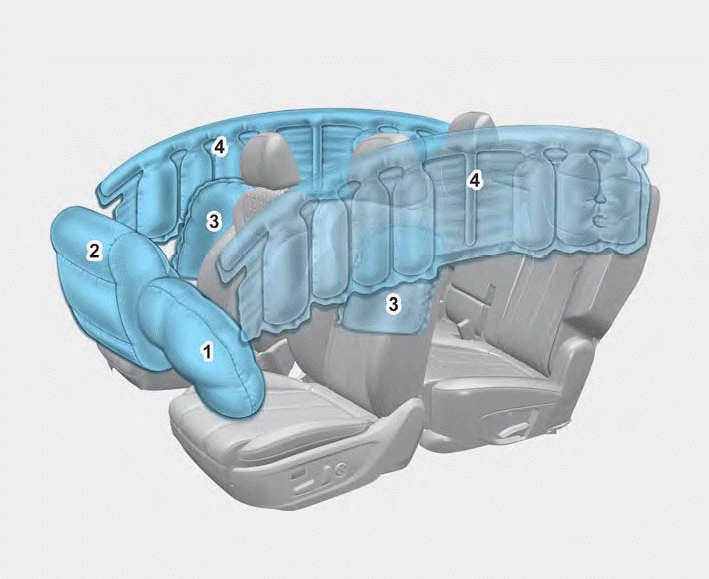Hyundai Santa Fe: Automatic Transaxle Control System / Transaxle Control Module (TCM). Repair procedures
Hyundai Santa Fe (TM) 2019-2025 Service Manual / Automatic Transaxle System (SBC) / Automatic Transaxle Control System / Transaxle Control Module (TCM). Repair procedures
| Inspection |
| 1. |
TCM ground circuit test : Measure the resistance between TCM and chassis
ground.
(Inspect the terminal connected to the chassis ground with the back
of harness connector as the inspection point of TCM side.)
|
| 2. |
TCM connector test : Disconnect the TCM connector and visually check
the ground terminals on TCM side and harness side for bent pins or poor
contact pressure.
|
| 3. |
If problem is not found in Steps 1 and 2, the TCM could be faulty.
If so, replace the TCM with a new one, and then check the vehicle again.
If the vehicle operates normally then the problem was likely with the
TCM.
|
| 4. |
Reinspection of original TCM : Install the original TCM (probably broken)
into a known-good vehicle and check the vehicle. If the problem occurs
again, replace the original TCM with a new one.
If the problem does not reoccur, this is an intermittent problem and
other part may be faulty.
|
| Removal |
| 1. |
Perform the oil pressure characteristics backup procedure using the
diagnostic tool when replacing with a new TCM.
|
| 2. |
Turn ignition switch OFF and disconnect the negative (-) battery cable.
|
| 3. |
Remove the air cleaner assembly.
(Refer to Engine Mechanical System - "Air Cleaner")
|
| 4. |
Remove the TCM.
|
| Installation |
| 1. |
To install, reverse the removal procedure.
|
| 2. |
Oil-pressure characteristics input (TCM exchange)
|
 Transaxle Control Module (TCM). Schematic diagrams
Transaxle Control Module (TCM). Schematic diagrams
TCM Connector and Terminal
Function
TCM Terminal Function
Connector [A]
Pin No
Description
Connected to
1
Power ground
Chassis Ground
2
-
-
3
-
-
4
-
-
5
-
-
6
Fuel Sender Signal
Fuel Sender
7
-
-
8
-
-
9
-
-
10
-
-
11
-
-
12
-
-
13
-
-
14
-
-
15
Stop Lamp Signal
Stop Lamp
16
Brake Test Switch
Brake Switch
17
18
-
19
-
20
Output Speed (Supply)
ATM Solenoid Valve (Otput Speed)
21
Input Speed (Supply)
ATM Solenoid Valve (Input Speed)
22
-
-
23
-
-
24
-
-
25
-
-
26
-
-
27
[A/T] SOL...
 Transaxle Oil Temperature Sensor. Description and operation
Transaxle Oil Temperature Sensor. Description and operation
Description
•
Transaxle oil temperature sensor monitors the automatic transaxle fluid's
temperature and conveys the readings to TCM...
Other information:
Hyundai Santa Fe (TM) 2019-2025 Owner's Manual: Exterior Overview
Exterior Overview (Front View) 1. Hood 2. Headlight 3. Tires and wheels 4. Side view mirror 5. Sunroof 6. Front windshield wiper blades 7. Windows 8. Front ultrasonic sensors Exterior Overview (Rear View) 9. Door Handle 10. Fuel filler door 11. Rear combination lamp 12...
Hyundai Santa Fe (TM) 2019-2025 Owner's Manual: Driving your vehicle
WARNING Carbon monoxide (CO) gas is toxic. Breathing CO can cause unconsciousness and death. Engine exhaust contains carbon monoxide which cannot be seen or smelled. Do not inhale engine exhaust. If at any time you smell engine exhaust inside the vehicle, open the windows immediately...
Categories
- Manuals Home
- 4th Generation Santa Fe Owners Manual
- 4th Generation Santa Fe Service Manual
- Resetting the power liftgate
- Power adjustment
- Child-protector rear door locks
- New on site
- Most important about car
Air bag - supplemental restraint system

1. Driver’s front air bag
2. Passenger’s front air bag
3. Side air bag
4. Curtain air bag
The vehicles are equipped with a Supplemental Air Bag System for the driver’s seat and front passenger’s seats.
The front air bags are designed to supplement the three-point seat belts. For these air bags to provide protection, the seat belts must be worn at all times when driving.
Copyright © 2025 www.hsafe4.com







